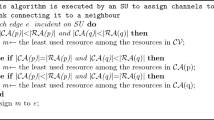Abstract
In this paper the effect of the opportunistic spectrum access on the spectrum utilization is studied in terms of the secondary network capacity measured at the secondary receiver. A mathematical model is developed to represent the secondary network capacity in Rayleigh fading channel. An exact analytical solution for the capacity is derived for both sensing and accessing fading channels. A numerical evaluation of the channel capacity is presented for different channel sensing and accessing schemes. The effects of detection and accessing channel parameters on the capacity are investigated. The analytical results that are validated by substantial simulations showed how the utilization of the network can be increased significantly by the suggested opportunistic spectrum accessing technique. It was found that when having a good sensing system with a high secondary user signal to noise ratio, accessing the licensed band increases and drives the spectrum utilization to its maximum. In addition, this work shows how the capacity can be positively affected by three factors: the secondary accessing channel, the primary user interference and the desired quality of service (QoS) of primary user. The awareness of a proper sensing scheme can maximize the spectrum utilization without degrading the QoS of primary users.








Similar content being viewed by others
References
Federal Communications Commission. Spectrum Policy task force report (ET Docket No. 02–135), November 2002.
Weiss, T., & Jondral, F. (2004). Spectrum pooling: An innovative strategy for the enhancement of spectrum efficiency. IEEE Communications Magazine, 42(3), S8–14.
Mitola, J.I. (2000). Cognitive radio: An integrated agent architecture for software defined radio, Ph.D. Thesis, KTH, Stockholm, Sweden.
Mitola, J. I., & Maguire, G. Q. J. (1999). Cognitive radio: Making software radios more personal. IEEE Personal Communications, 6(4), 13–18.
Haykin, S. (2005). Cognitive radio: “Brain-empowered wireless communications”. IEEE Journal on Selected Areas in Communications, 23(2), 201–220.
Haykin, S., Thomson, D., & Reed, J. (2009). Spectrum sensing for cognitive radio. Proceedings of the IEEE, 97(5), 849–877.
Urkowitz, H. (1967). Energy detection of unknown deterministic signals. Proceedings of the IEEE, 55(4), 523–531.
Ghasemi, A., & Sousa, E. (2007). Opportunistic spectrum access in fading channels through collaborative sensing. Journal of Communications, 2, 2.
Digham, F. F., & Alouni, M. (2007). On the energy detection of unknown signals over fading channels. IEEE Transactions on Communications, 55, 1.
Al Bashir, O., & Abdel-Hafez, M. (2011). Opportunistic spectrum access using collaborative sensing in Nakagami-m fading channel with real fading parameter. In IWCMC 2011, July 5–8, in Istanbul, Turkey.
Liang, Y.-C., Zeng, Y., Peh, E., & Hoang, T. (2008). Sensing-throughput trade-off for cognetive radio networks. IEEE Transactions on Wireless Communications, 7(4), 1326–1337.
El-Saleh, A. A., Ismail, M., Ali, M. A. M., & Alnuaimy, A. (2009). Capacity optimization for local and cooperative spectrum sensing in cognitive radio networks. In World academy of science, engineering and technology, 50.
Sun, J., & Zhu, H. (2009). Channel capacity analysis of spectrum-sharing with imperfect channel sensing. In ChinaCom2009-wireless communications and networking symposium.
Cho, H., & Andrews, J. G. (2009). Upper bound on the capacity of cognitive radio without cooperation. IEEE Transactions on Wireless Communications, 8(9), 4380–4385.
Papoulis, A. (1991). Probability, random variables, and stochastic processes, 3rd edn. McGraw-Hill, NY.
Gryadshteyn, I. S., & Ryzhik, I. M. (1996). Table of integrals, series, and products. San Diego: Academic Press.
Shannon, C. (1948). A mathmatical theory of communication. Bell System Technology Journal, 27, 623–656.
Abramowitz, M., & Stegun, I. A. (1970). Handbook of mathematical functions. NY: Dover.
Nuttal, A. H. (1975). Some integral involving the \(Q_M\) function. Naval Underwater Systems.
Author information
Authors and Affiliations
Corresponding author
Rights and permissions
About this article
Cite this article
Abdel-Hafez, M., Shuaib, K. & El-Bashir Hamed, O. On the Capacity of Secondary Networks Over Opportunistic Spectrum Access in Rayleigh Fading Channels. Wireless Pers Commun 78, 1981–1994 (2014). https://doi.org/10.1007/s11277-014-2057-8
Published:
Issue Date:
DOI: https://doi.org/10.1007/s11277-014-2057-8




